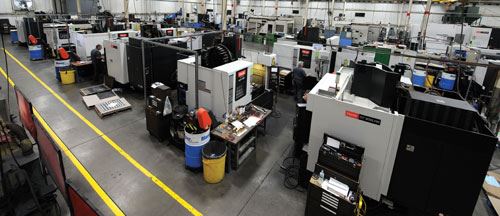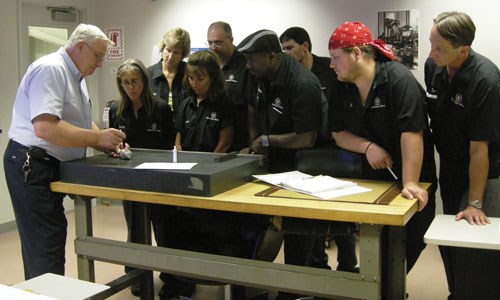Almost half of the respondents to our 2012 Top Shops benchmarking survey gave an answer to the open-ended question, “Briefly explain the machining technology or strategy that contributed the most to the overall success of your business in recent years.” Although the answers were diverse and far-ranging, several themes emerge clearly.
The methodology to this analysis was very simple. The words or sets of related terms that appeared most often provided clues to what respondents consider important. About 165 survey takers provided input to this question, but about three quarters of them listed more than one strategy or technology as having the biggest influence. This gave us a rich sample to investigate and interpret.
Management strategies or principles were mentioned far more often than specific technologies. Only about a dozen answers pinpointed a single machining process or technology, such as “hard milling,” “modular fixturing” or “high-speed machining.” One inference here is that shop management is more about sound strategic thinking than tactical applications.
Focus on the Customer
One striking characteristic of the body of responses was the conspicuous recurrence of a single word: customer. “Keep the customer happy,” “meet customer needs,” “respond to customer requests” and “guarantee customer satisfaction” were the typical contexts for this usage. It occurred 24 times among the answers—no other single word approached this frequency. This does not count several answers that mentioned “service” where the meaning was clearly “customer service.”
Several answers implied a more nuanced emphasis on customer relationships. For example, one respondent mentioned “advising customers on more economical solutions.” Another spoke of “consulting with customers to add value.” “Providing personal service to the customer” and “building customer confidence” were also suggested as success factors.
Although a focus on the customer is a part of basic business sense, shops that develop and expand this advisory role to customers have an advantage. For one thing, this approach shifts attention away from a “choose the lowest bidder” mentality to one of “find the shop that gives the most value.” For another, greater responsiveness and interaction are cited by proponents of “reshoring” initiatives as a key reason for large manufacturers and OEMs to return to domestic suppliers, job shops and contract manufacturers. Strong customer relationships are part of the appeal of reshoring.
Invest in Technology
The machining technologies that are prevalent among Top Shops were examined in detail by the survey. See the article on page 74 for this analysis. The importance of continual investment in technology as a management priority, however, was amply reinforced in answers to the open question. At least 25 answers cite “new technology,” “upgraded machines,” “replacements,” “modernization,” “advances,” “the latest” or similar terms as a reason for overall success.
Most of these answers did not indicate specific targets for this investment, but rather a general principle of keeping up with new technology. As a matter of fact, survey questions that asked about spending on capital equipment and tooling showed that Top Shops outspend other shops in every category. The following answers to the open-ended question were typical:
• “Latest tooling and machining centers, CAD/CAM technology and good, smart and talented employees.”
• “Modernizing to new equipment along with making employees understand spindle utilization.”
• “Continued development and incorporation of new technologies supported by a commitment to continuous improvement has been key to our success in new business development.”
Of course, the respondents that did give information about specific technologies or processes as key success factors deserve a mention here. “Cells,” “automation” and “unattended machining” were the most frequent short answers indicating these shops’ investment priorities.
Another favored tactic is indicated in these responses:
• “We plan to work so all personnel can run multiple machines.”
• “More machines than people.”
• “Add ops together to allow fewer operators to run more machines.”
• “Our strategy is to move to modern multitasking equipment, taking the labor out of the process.”
These results confirm other industry reports that note the uptick in the manufacturing sector without the expected growth of new jobs. Companies are clearly more interested in adding new technology than increasing the headcount.
Continuous Improvement and Lean
“Continuous improvement” was the exact phrase respondents used most often to single out a shopfloor practice that contributes the most to success. Twice as many respondents cited lean manufacturing or a specific lean technique, such as kaizen, kanban or 5S. Altogether, about 30 total responses mentioned a form of continuous improvement.
For many shops, setup time reduction is one of the most rewarding results when lean manufacturing is first implemented, because so much waste and inefficiency are hidden by poorly managed setup procedures. Reduced setup time was a prominent theme in several responses. This sample is representative:
• “We do a lot of short runs, so improvements in setup time count.”
• “Standardizing tooling and optimizing setups and run times.”
• “Both 5S and kaizen events focused on reducing machine setup times.”
Also mentioned numerous times as success factors were “quick turnaround,” “short lead times” and “quick response manufacturing.”
Adopting lean manufacturing practices is often described as a journey. Lean manufacturing always seeks to move to a “future state” with less waste, but the journey has no final destination. This sense of “lean as journey” came through in several responses, but most clearly in this:
• “(We) began using basic tools for lean manufacturing in 2007, with a stronger push beginning in 2010. We began seeing big rewards in late 2010 with better on-time delivery, uptime and efficiency.”
That continuous improvement and lean were frequently credited as significant contributors to success is not a surprise. The table on page 92 details the prevalence of these practices. Most notable is the finding that 80 percent of Top Shops are pursuing some sort of continuous improvement program.
Training
Next to “customer,” the most frequently used single word among all of the responses was “training.” A half-dozen responses mentioned training as the one factor contributing the most to their shops’ success. Just as common, however, were responses that listed training and skills development alongside technology or some other shopfloor practice as a “strategic package.” Consider these responses:
• “Automated processes, machinery upgrades, employee crosstraining.”
• “Invested heavily in new equipment, software and training of young machinists.”
• “Technology of the machines and training.”
• “Emphasis on investing in technology and training to reduce number of operations needed to produce parts.”
What kind of training shops are pursuing is a good question. The survey responses did not give any strong clue. However, formal training does not appear to be a top consideration. The table below shows findings from this year’s survey.
It is more likely that Top Shops and shops in general make training an integral part of the regular shop routine, with classroom or off-site training being the exception rather than the rule. This is strictly an interpretation, as the responses do not provide solid evidence.
Blend and Balance
Success in manufacturing seems to be an effective blend of technology and people. You might call this blend “know-how.” Know-how is not possessed equally among manufacturing companies. Some apply processes and equipment more productively and profitably than others, for example.
Keeping the importance of this know-how in mind is a good way to balance the value of what machines and equipment can do and the value of what a shopfloor workforce can do. It is no secret that Top Shops maintain a balance of these capabilities at a very high level.




























